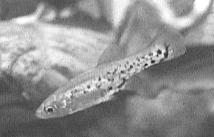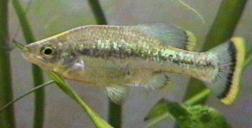
Young fry from the author’s tank
For the last year or so I’ve been interested in the goodeids from Mexico. That interest has been fueled by the availability of them through friends in both the Greater Portland Aquarium Society, and the Kitsap Aquarium Society. Goodeids are not often seen in fish shops, probably due to their lack of bright colors to attract customers, but they are worth keeping for a few reasons. Most species are endangered due to habitat destruction. This is what attracted me to them at first. As livebearers, they are unique in that they nourish the developing embryos through a specialized structure, the trophotaenia, the remnants of which are visible on the fry for a short time after birth.
As Eilene Alvis was giving me a tour of her fish room I noticed a large trio of Ameca splendens cavorting around one of her tanks. I had read about them in Wiscanth’s Atlas of Livebearers but was excited to actually see them. Eilene kindly traded them to me for some cichlids and I was on my way to crank out tons of fry. After all, they are live bearers.

The butterfly goodeid gets its name from the male’s black stripe in the middle of the tail finishing in a bright yellow band on the margin of the caudal fin. The body of both sexes is grey with an indistinct dark lateral line. Females have several small black spots on the body and the unpaired fins have spots and/ or streaks of black as well. They are big, bulky fish. Males and females get almost 4 inches in total length. The male was so aggressive that I removed him from the community tank they were sharing with pencil fish, Siamese algae eaters, Microgeophagus altispinosa, and a few Pelvicachromis taeniatus males.
 Young fry from the author’s tank |
In spite of a published reputation as good community fish, the females continued to eat like pigs, push the other fish away from food, and supply a lot of fuel for the nitrogen cycle in my tank. They didn’t even appear to be getting fatter. After about two months I began to worry that they hadn’t been fertilized by the male because the gestation time is supposed to be 50 to 60 days. At three months one of the females finally looked gravid. I now thought that a birth was soon to be. I had made sure that there were plenty of hiding places for the fry by allowing water sprite and frog bit to cover the surface of their 55 gal tank. Another 3 weeks went by and then upon feeding the tank I noticed that the belly of the pregnant female was flaccid like a balloon that had been over inflated and then allowed to deflate. Six fry had been delivered. I expected them to be large like other goodeid fry but these one inch newborns really astonished me. They were not even hiding from the other tank inhabitants, but out competing for food. Needless to say they don’t require any of the normal fry foods most fish require.
I wouldn’t recommend anything less than a 20 gallon tank for these bruisers and probably a 55 gal is best, lots of plants as an ammonia sponge, a little algae for them to graze on, tons of foods, and a helping of patience. They appreciate warm temperatures in the 75-80 degree range and a neutral pH. As omnivores they should have a varied diet that includes some spirulina and they relish live adult brine shrimp.
So if you are looking for a change of pace from the hybrid, inbred, mutated forms of common livebearers then check out some of the goodeids. You can help prevent their loss to the hobby not to mention the planet!
When not at his real job as a teacher, Dave is busy breeding
virtually every kind of dwarf cichlid in his home. Dave is responsible
for keeping many local stores stocked with Moliwe
taeniatus and
Apistogramma cacatuoides. He’s written numerous articles for this
publication.